Top Data Science Tools That Will Empower Your Data Exploration Processes
Data science has become an extremely rewarding career choice for people interested in extracting, manipulating, and generating insights out of large volumes of data. To fully leverage the power of data science, scientists often need to obtain skills in databases, statistical programming tools, and online data visualization. Companies need data scientists to help them empower their analytics processes, build a numbers-based strategy that will boost their bottom line, and ensure that enormous amounts of data are translated into actionable insights - enter the world of data science tools.
But being an inquisitive Sherlock Holmes of data is no easy task. There are a number of tools available on the market, and knowing which one to choose to increase performance can be time-consuming, and often confusing. Not to forget various areas of data scientists employed in, from academia to IT companies.
But we will not focus on their choice of industry, instead, we will take a closer look at the basic definition of these tools, and consider the most popular data science tools and software on the market in order to maximize the scientist’s role in an organization and/or company. Finally, we will expound on data science visualization tools that create powerful interactive dashboards by using a modern dashboard creator.
Let’s get started.
What Is A Data Science Tool?
Data science tools are used for drilling down into complex data by extracting, processing, and analyzing structured or unstructured data to effectively generate useful information while combining computer science, statistics, predictive analytics, and deep learning.
In the past, data scientists had to rely on powerful computers to manage large volumes of data. Thanks to modern online data analysis processes, today the costs are decreased since all the data is stored on a cloud that, ultimately, speeds up the process to make better business decisions.
The usage of modern and sophisticated tools has the goal to make data science faster, deeper, more effective while blending together several hundreds of routines that enable the standardization and cleanup of the data for you. Therefore, there are numerous data science tools and techniques that provide scientists with an easier, more digestible workflow and powerful results. To learn more about different analytical possibilities, you can explore our resource on self-service analytics tools.
Here, we list the best data science tools and software used in various industries and take a closer look at key functions and usage of each in order to make your choice of utilizing such solutions easier and lighter.
What Software & Tools Do Data Scientists Use?
The tools for data science benefit both scientists and analysts in their data quality management and control processes. But they’re not just limited to this, therefore, we will mention the top tools that data scientists utilize to delve into data, and extract actionable insights. Let’s start with RStudio and the R programming language.
1. R (And RStudio)
We begin our list of the top data science tools with R and RStudio. As most data scientists have probably heard of, RStudio is an open-source solution that allows to clean, manipulate, but also analyze data. It helps to automate and makes the usage of the R programming statistical language easier and much more effective. R users typically come from science, education, and various other industries that need statistical computing and design in their processes. Big companies that utilize R in their analytics operations, such as Google, Facebook, and LinkedIn, usually are finance and analytics-driven, as R has proved to be the top mechanism for data analysis, statistics, and machine learning.
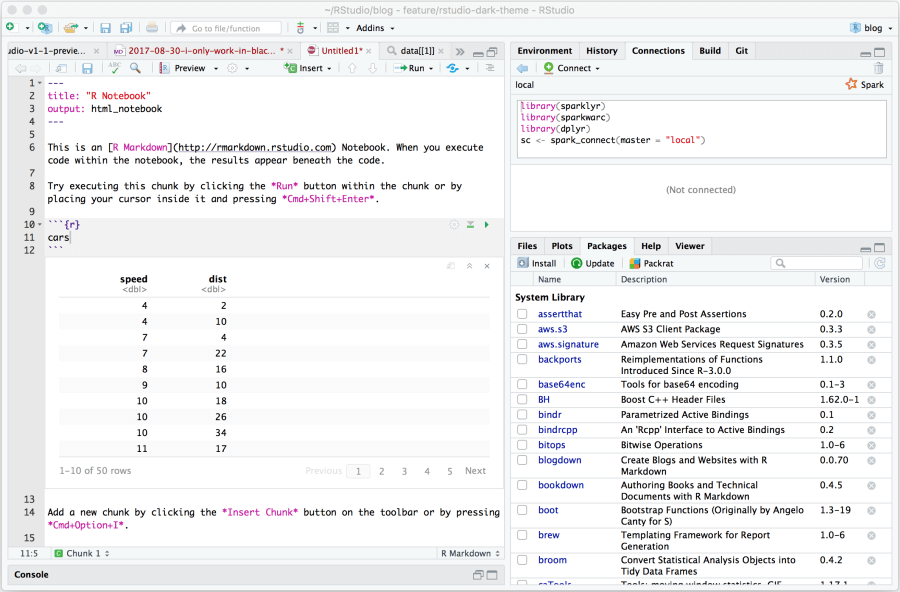
**Source: RStudio
R is platform-independent, meaning it can be easily applied in each operating system. The major features that this data science tool offers are the ability for extensive data exploration combined with integration with other languages such as C++, Java or Python. Many users also report its power in constructed-in capabilities and libraries, data manipulation, and reporting. Whether the company needs a comprehensive financial analytics strategy or process, R has become one of the most used data science tools to explore and manage data.
Key functions and usage:
- available in both open-source and commercial use
- provides the user with visualizations, code editor, and debugging
- perfect for statistical computing and design
2. Python
We continue our list of the top data scientist tools with Python. Together with R, this programming language makes the state of the art towards data science tools and techniques. In an ideal world, learning both would be a perfect solution, but we will not concentrate much on that.
Instead, we will talk about how Python enables data scientists to begin their journey into this exciting field, but also want to explore the world of programming since Python was primarily developed as a programming language. It offers a wide range of libraries attractive for both programmers and data scientists such as seaborn or TensorFlow. But its popularity within data science is also based on the possibility to clean, manipulate, and analyze data, just like R. They do have differences, and the user has to finally decide which one fits better in their needs to work with data, but Python has emerged as one of the most prominent data scientist tools out there. In fact, there are numerous tools built with or connected with Python, such as SciPy, Dask, HPAT, and Cython, among others, which makes this programming language among the top choices of striving data scientists who would love to grow in the field.
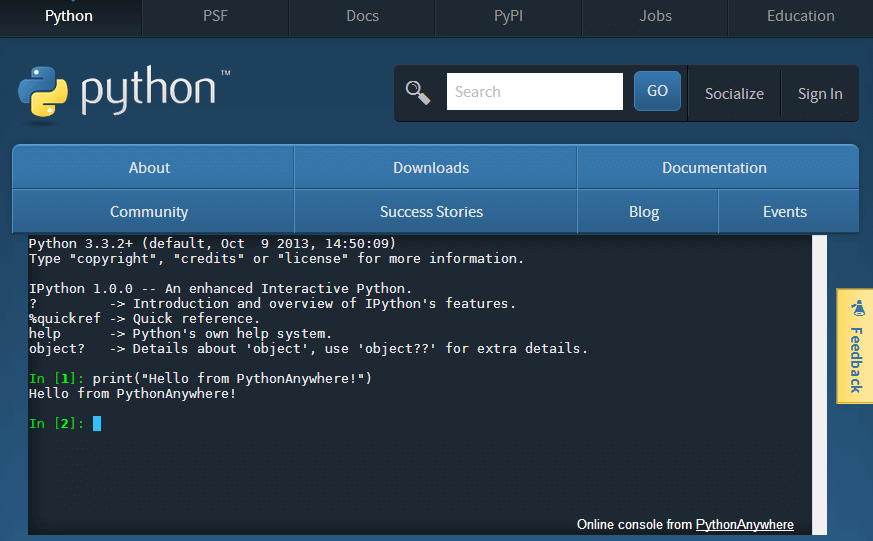
**Source: python.org
The industry loves Python since scientists are usually looking for tools that will enable them a simple programming experience, without much hassles and potential complexities. It’s a general-purpose programming language, preferred by 55% of data scientists with less than 5 years in the field. That only confirms that Python is one of the top data science software on our list.
But not only, as the TIOBE index confirms that the popularity of Python is increasing. As a matter of fact, Python was declared as one of the top 3 most popular languages in 2020, and it will surely grow in the future as well.
Key functions and usage:
- offers a wide range of libraries; connected with numerous other tools
- used for cleaning, manipulating, and analyzing data
- preferred by almost half of the data scientists with less than 5 years in the industry
3. BI Tools And Applications
Business intelligence has developed into one of the most powerful solutions for companies that look for smart data analysis, predicting the future, and utilizing BI tools for generating actionable insights. There are many differences between business intelligence and data science, but with the recent development of BI tools, both became closely interconnected and dependent on each other.
The use of machine learning, predictive analytics, and various data connectors that enable the user to work with enormous amounts of databases, flat files, marketing analytics, CRM, etc., and share them with just a few clicks while all the information is stored on a cloud, enabled data scientists to use virtualization to their advantage, and utilize their selected data science software not just as a powerful tool, but also as a working environment to work with data on a scalable solution. There are also numerous business intelligence examples that illustrate what kind of value it can bring to the business bottom line. To put this into perspective, let's take a look at an example:
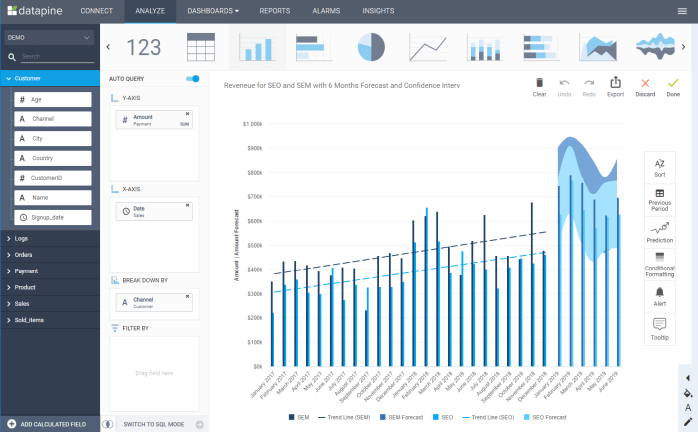
The example above shows us a visual of the drag and drop interface created in datapine for a 6 months forecast based on past and current data. This is extremely useful in scenarios where future predictions can provide a backbone for defining forthcoming business strategies and decisions which would, otherwise, be based on possible human errors and "hunches." The predictive analytics possibilities are developed in a simple, yet straightforward way, where you only need to enter your specified data points based on your past data, choose the confidence interval and the forecast engine will do the rest.
It is a fact that companies have become more data-driven, require a deep dependence on information, but need someone who can own the process of managing their data, often also of sensible nature. Business intelligence solutions not only provide the possibility to manipulate the data but also create powerful dashboards and reports that translate the work of data scientists to real business scenarios protected with high-security levels. These tools for data science offer additional aspects in dealing with information. They might implement a MySQL report builder to relieve the IT department from carrying out SQL queries and, therefore, save enormous amounts of resources and create a cost-effective business environment.
The possibilities within business intelligence are endless, and by using modern data science visualization tools in the form of BI software, scientists can become the backbone of a successful business strategy.
Key functions and usage:
- cloud data storage; availability 24/7/365
- scalable and adjustable according to the needs of the user
- connecting data sources and predicting future outcomes
4. Jupyter
Jupyter, know as a computational notebook, is one of the open-source data science tools that was born out of the Python Project back in 2014 and, since then, became renowned for its possibilities to combine software code, support scientific computing across all programming languages such as Python, Julia, R, and Fortran, among dozens of others (more than 40, to be exact). An interesting fact about Jupyter is that it will be used in astronomy to process terabytes of data each night for the Large Synoptic Survey Telescope (LSST) project. This notion definitely confirms that the data migration power of the tool is undeniable.
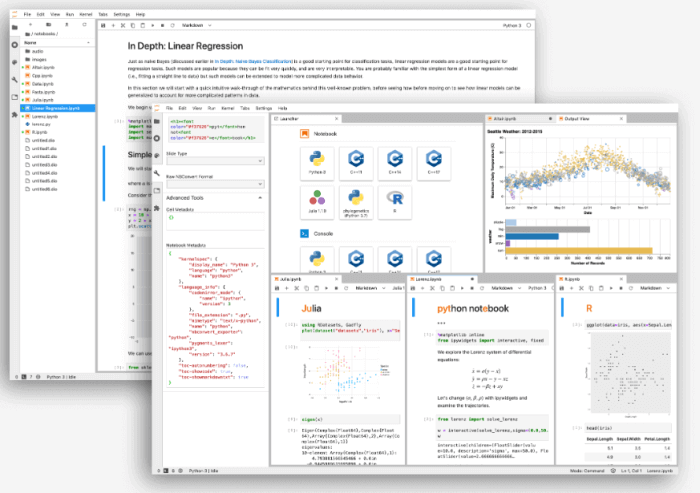
**Source: jupyter.org
The tool works as a computational notebook, as mentioned, that contains live code, equations, visualizations, and text. It's consisted of the language of choice, sharing notebooks, interactive outputs such as images, videos, HTML, or custom MIME types, and integration with other data analysts tools and big data solutions such as Apache Spark. They also provide a hub for pluggable authentication, centralized deployment, and container friendly features so it's not unusual to see giants such as IBM, Google, or Soundcloud that are currently using it.
Key functions and usage:
- supports more than 40 programming languages
- interactive computing features based on computational Kernels
- integrates with other big data solutions such as Apache Spark
5. BigML
Our data science tools and technologies list wouldn't be complete without machine learning (ML), therefore, you might want to consider BigML. It's a scalable machine learning platform that enables users to solve and automate regression, classification, cluster analysis, anomaly detection, and time series forecasting, among other prominent features. Their philosophy is focused on making machine learning simple, and if you want to use it for educational purposes, you can obtain a free account (they currently serve more than 600 universities across the globe). Additionally, you can sign up for a prime account that will enable you to collaborate on projects with team members.
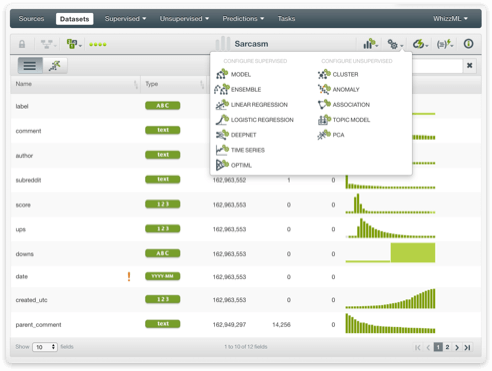
**Source: bigml.com
The product can be used as an online data science tool as well as locally, embedded into applications and it's a comprehensive ML platform for both supervised and unsupervised learning (from logistic regressions, deepnets to topic modeling, and Principal Component Analysis). All predictive models within the tool come with interactive visualizations and explainability features. That way, you can easily interpret the visuals such as Partial Dependence Plots while BigML models can be easily exported via JSON PML and plugged into Google Sheets, Amazon Echo, or Zapier, among others.
With BigML, you can share your machine learning resources using their project management and granular team capabilities while libraries that are available for multiple popular languages such as Python, Java, Swifts, or Ruby, will enable you to easily program and trace your workflow at any time.
Key functions and usage:
- focused on machine learning capabilities
- provides supervised learning: classification, regression (linear regressions, trees, etc.), and time series forecasting
- offers also unsupervised learning: association discovery, cluster analysis, anomaly detection, etc.
6. Domino Data Lab
Domino Data Lab is a data science platform that enables users to build and implement models, run on machines with up to 2 terabytes of RAM, or on specialized GPUs for deep learning without being a DevOps expert. Their Reproducibility Engine automatically tracks and organizes all results of each conducted data experiment while the preconfigured computing stacks for research, including popular languages such as R, SAS, Jupyter, Tensorflow, or Python, will enable you to utilize a comprehensively managed data science platform for various industry functions and objectives.
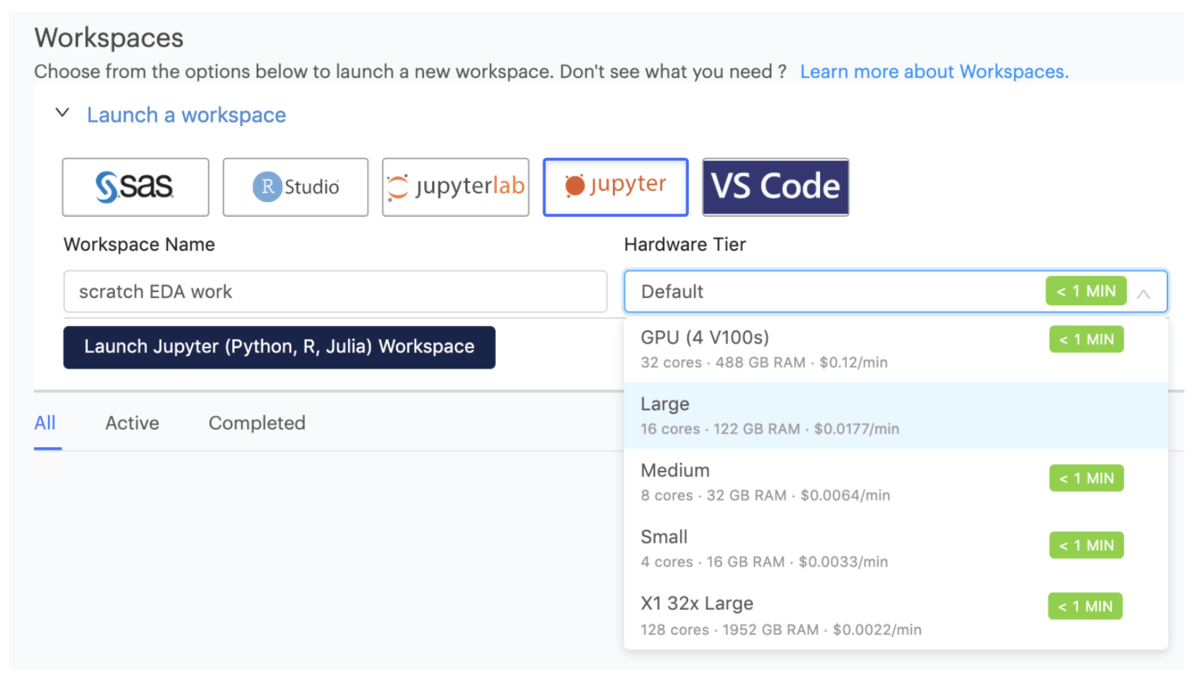
**Source: dominodatalab.com
You can also build your own custom environment and share it with your colleagues but also reconstructing experiments and results thanks to the mentioned Reproducibility Engine. They also support multiple modes of delivery, meaning you can fit models into existing workflows, send scheduled reports, or use self-service web forms. It can run in the cloud, on-premise, and hybrid environment, and is one of the tools for data scientists that tend to eliminate DevOps tasks.
You can deploy your work into their Kubernetes compute grid where you can monitor your model performance, and publish interactive apps built in Shiny or Flask. Additionally, their Control Center will enable you to check your team's performance, allocate tasks more effectively, and gain a complete overview of your team's work. Tutorials and pre-built environments can also help in faster onboarding so any team member can pick up the work where others have left off - project's artifacts and history is available at all times.
Key functions and usage:
- includes solutions such as model management and cloud data science
- the Reproducibility Engine reconstructs experiments and results
- tends to eliminate DevOps tasks
7. SQL Consoles
The tools of a data scientist list wouldn’t be complete without SQL consoles such as MySQL Workbench, which we will give our focus on – this language is used for database management, querying, and analysis. In fact, MySQL Workbench is a visual tool that provides “data modeling, SQL development, and administration tools for server configuration, backup, and much more,” according to the product listing at the MySQL website. It has numerous features such as creating and viewing databases, executing and optimizing SQL queries, viewing server status, performing backup and recovery, and much more.
This is one of the most prominent data science visualization tools offered both for open-source and commercial use. This database management tool offers a variety of possibilities to keep a data-driven application running smoothly which is critical for organizations that need their databases clean and effective.
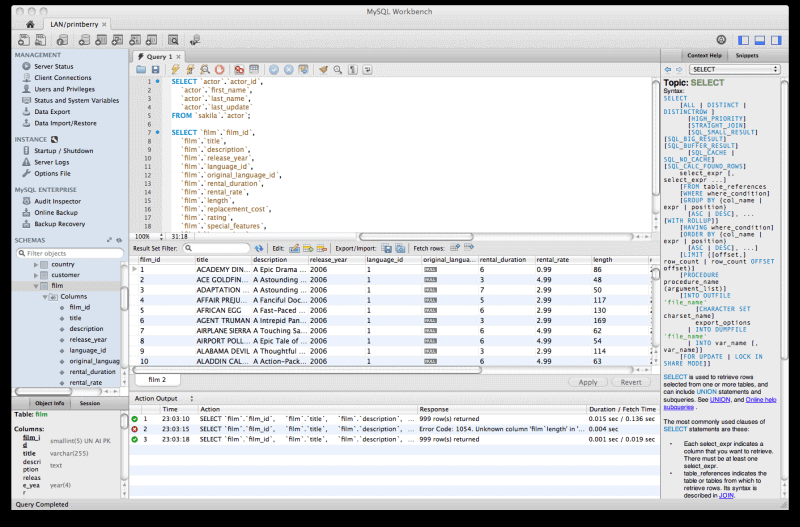
**Source: mysql.com
The field requires storing data in an accessible, and uncomplicated way; therefore, this language is the most convenient method a data scientist can use. Additionally, if you want more details about the topic and broaden your knowledge, you can read our resources on SQL reporting tools.
Key functions and usage:
- database management, analysis, querying
- performing backup and recovery
- offered both as open-source and commercial use
8. MATLAB
We finish our list of the best data science software tools with MATLAB. It’s still utilized in most of the academic areas, especially in (scientific) research. Computational mathematics is in the heart of this language, typically used in algorithm development, modeling and simulation, scientific and engineering graphics, data analysis, and exploration. It offers many statistics and machine learning functionalities such as predictive models for future forecasting.
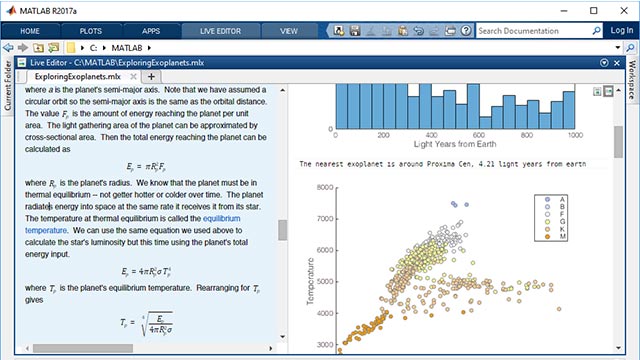
**Source: mathworks.com
This is one of the tools of a data scientist that utilizes physical-world data by offering native support for real-time formats (sensor, image, video, binary, etc.). It also provides thousands of pre-built algorithms for financial modeling, image and video processing, control system design, and much more. Learning MATLAB is an excellent bonus for those who want to pursue a career in (academic) research.
Key functions and usage:
- utilized mostly in academia with a strong focus on computational mathematics
- offers many statistics and machine learning abilities
- thousands of pre-built algorithms
9. KNIME Analytics Platform
KNIME Analytics is a platform that can be used for enterprise data science as well as an open-source solution through 2 main products: KNIME Platform and KNIME Server. Here we will focus on the Platform that features visual workflows, a choice from over 2000 nodes, including native ones and from different domains, and the possibility to use publicly available workflows or a workflow coach. With the platform, you can combine text formats, unstructured or time series data, and connect to a host of databases and data warehouses to integrate your data, including Oracle, Apache Hive, Load Avro, Parquet, etc.
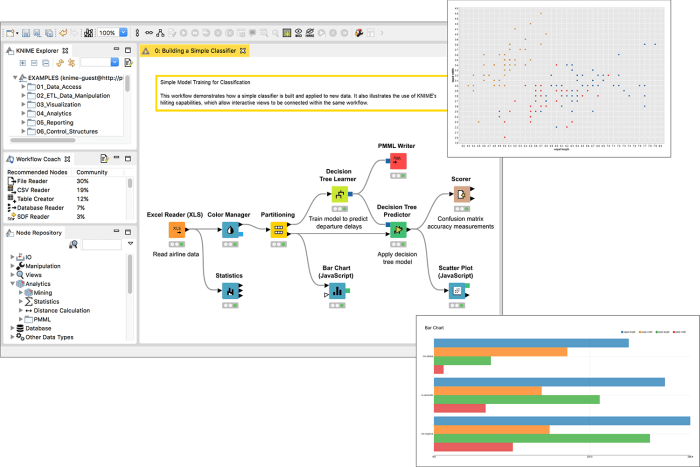
**Source: knime.com
You can shape your data by deriving statistics, including mean, quantiles, and standard deviation, or applying statistical tests, and integrating dimensions reduction and correlation analysis. Sorting, filtering, and joining data can be done on your local machine or in distributed big data environments while you can clean your data through normalisation, data type conversion, and missing value handling.
If you want to go a step further, you can build machine learning models for classification, regression, dimensions reduction, or clustering by using advanced algorithms such as deep learning. You can also visualize your data with classic bar charts and scatter plots, for example, and export as .pdf or a PowerPoint presentation.
Key functions and usage:
- a choice of over 2000 nodes (native and from different domains)
- you can derive statistics, integrate dimensions reduction and correlation analysis
- offers the possibility to build machine learning models by using deep learning
10. Microsoft Excel
We finish our roundup of the tools for data scientists with Excel as one of the traditional solutions that are still present today in numerous analysis processes and it's a fairly classical tool for analyzing, manipulating, calculating, and visualizing your efforts through a spreadsheet. Various formulas, filters, slicers, and tables will enable you to customize your analytical efforts, and explore your data, but on a smaller scale in comparison to other data scientist software from our list such as datapine or Python. This is one of the business-specific data science tools since it can fit departments that need to create a procurement reporting process, for example, and present their numbers in a spreadsheet that can be easily shared or manipulated by using columns and rows.
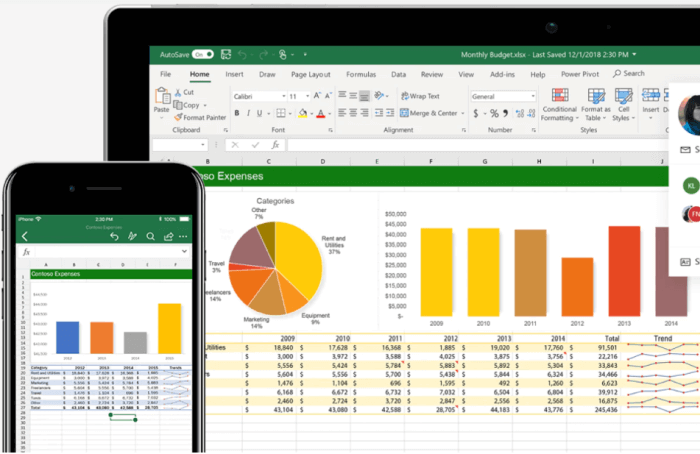
**Source: microsoft.com
That said, it's highly popular for spreadsheets calculations, and data scientists can use it for cleaning as it's fairly simple to use in order to edit 2-dimensional data (in essence, tables). Oftentimes considered as a bridge between advanced data scientists and average business users, Excel has its power to provide a set of features and possibilities that can accommodate both, especially if you're just getting started in data manipulation and analytical processes. Excel is also considered as one of the tools that you can combine with others and it certainly gives us a reason that it survived and thrived since it was published back in the 90s.
No matter if you need to build a sales chart or simply calculate endless rows and columns, Excel will give you some basic features that you can start with, and then you can decide if you want to utilize more advanced tools from our list.
Key functions and usage:
- good for analyzing and cleaning 2-dimensional data
- uses historical data, analyzed on a smaller scale
- works well for beginners as most people are acquainted with Excel
We have listed the best data science software tools for various fields that can be used in, whether small business analytics or scientific research. It contains so many areas that this list could go on, but, in the end, it all depends on what the focus area of the data scientist is, and how advanced his analysis needs to be.
The success of the modern analytics strategy, whether academic, business, or industrial, depends on the data. Utilizing the right data science software and tools is crucial to develop practical values of the projects, but the context in which data exists is completely dependent on data scientists. We hope that this list of the best software for data science has given you a good overview of the possibilities of each and made your choice much easier, no matter if you need an enterprise software solution or a more simple and open-source.
If you want to have practical experiences of data and science, learn about various ways of analyzing your data, developing practical insights, monitoring and extracting your findings, then try modern business intelligence software like datapine for a 14-day trial, completely free!
Nhận xét
Đăng nhận xét